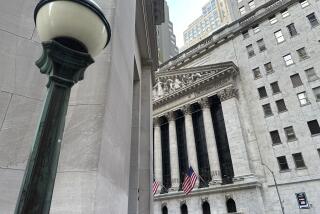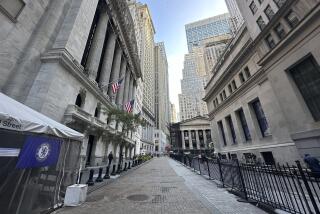Greenspan Remarks Send Bond Yields Up
Longer-term bond yields soared again Tuesday, reaching three-month highs, as Federal Reserve Chairman Alan Greenspan painted a relatively upbeat outlook for the economy.
The latest surge in yields should force more investors to consider how much they can stand to lose on fixed-income securities if the trend continues -- because it probably will, many analysts say.
Heavy selling of bonds Tuesday resulted in one of the biggest single-day jumps in yields in recent years.
The yield on the 10-year Treasury note, a benchmark for mortgage rates and other long-term rates, rocketed to 3.98% from 3.72% on Monday. Yields rise as bond prices decline.
The T-note’s yield now is the highest since mid-April and is well above the generational low of 3.11% reached June 13.
The dramatic turnaround in long-term Treasury rates doesn’t stem from a Fed threat to tighten credit. In fact, Greenspan told Congress on Tuesday that the Fed could keep short-term rates near current 45-year lows for “as long as necessary” to ensure an economic recovery.
Instead, bond pros say the market’s reversal in large part reflects that investors and traders got carried away in pushing yields lower in recent months.
Because long-term yields had fallen for three years, many investors assumed that could only continue. That left no room for the normal upward pressure on interest rates that might be expected to accompany an economic revival, analysts said.
In addition, Greenspan in May had encouraged investors to believe in an ongoing bond bull market by raising the specter of deflation -- a broad decline in prices. Deflation, essentially, is negative inflation. In that kind of environment, even 2% bond yields might be attractive.
Also in the spring, Fed officials hinted that they might resort to unconventional steps to help the economy. One of those steps, they suggested, would be for the Fed to buy long-term bonds in the marketplace to try to push yields down further.
In his testimony Tuesday, Greenspan appeared to downplay both deflation and the idea of the Fed buying bonds. He said a situation requiring bond purchases was unlikely to arise.
“You heard a demotion of the concept of unconventional Fed policy,” said John Hollyer, a bond portfolio manager at Vanguard Group in Valley Forge, Pa.
As more bond owners begin to contemplate the idea that interest rates have stopped declining, the market immediately becomes vulnerable to fears of higher rates, Hollyer said.
Knowing that rising yields devalue existing fixed-rate bonds, “Everyone wants to be out the door first now,” said Kathleen Gaffney, co-manager of the Loomis Sayles Bond fund in Boston.
The situation is worsened by the presence of hedge funds and other investors that piled into bonds since 2000 as that market rallied. In many cases, investors borrowed to buy bonds, which means they can’t afford to stick around now that bond values are falling, said James Bianco, head of bond research firm Bianco Research in Chicago.
“The bond market has a lot of leverage in it,” he said. “How much of that now has to be unwound, nobody knows. But it is absolutely a risk” to the market and makes it highly probable that yields will continue to rise in the near term, he said.
Another problem for the Treasury market, Bianco said, is that the government is projecting deficits exceeding $450 billion this year and next -- ensuring a huge supply of new bonds.
As long-term Treasury yields move higher, they are pulling up rates on many other bonds as well, including corporate, municipal and foreign issues.
As the securities fall in value, bond mutual fund investors are seeing their share prices slump.
The Fidelity Government Income fund, for example, has dropped from $10.87 a share June 13 to $10.44 as of Tuesday, a decline of nearly 4%. Year to date, however, the fund’s price is off a modest 0.4%, and its total return, including interest earnings, is a positive 1.3%.
But if yields continue to rise, bond fund prices are almost certain to lose more ground.
John Lonski, economist at Moody’s Investors Service in New York, said Greenspan’s optimistic assessment of the economy’s potential in 2004 -- the Fed predicts real gross domestic product growth of between 3.75% and 4.75% next year -- could justify a 10-year T-note yield of as much as 5%.
That may seem like a high yield, but it would just return the T-note to its mid-2002 level.
Still, Lonski said, “It isn’t going to be a straight line up in yields from here.” For one, higher yields would at some point lure investors hungry to lock in decent returns.
“If you wanted income, bonds give you more now,” Hollyer said.
Gaffney believes that, even if the economy is improving, that process should be “fairly protracted” -- meaning that it would take time to be evident. Any doubts along the way about the recovery could spark a new rush of bond buying, she said.
Analysts say bond investors should take time to assess what they own and how vulnerable their particular bonds are to rising rates. Panic selling usually is as bad an idea with bonds as it is with stocks, experts say.
More to Read
Inside the business of entertainment
The Wide Shot brings you news, analysis and insights on everything from streaming wars to production — and what it all means for the future.
You may occasionally receive promotional content from the Los Angeles Times.










